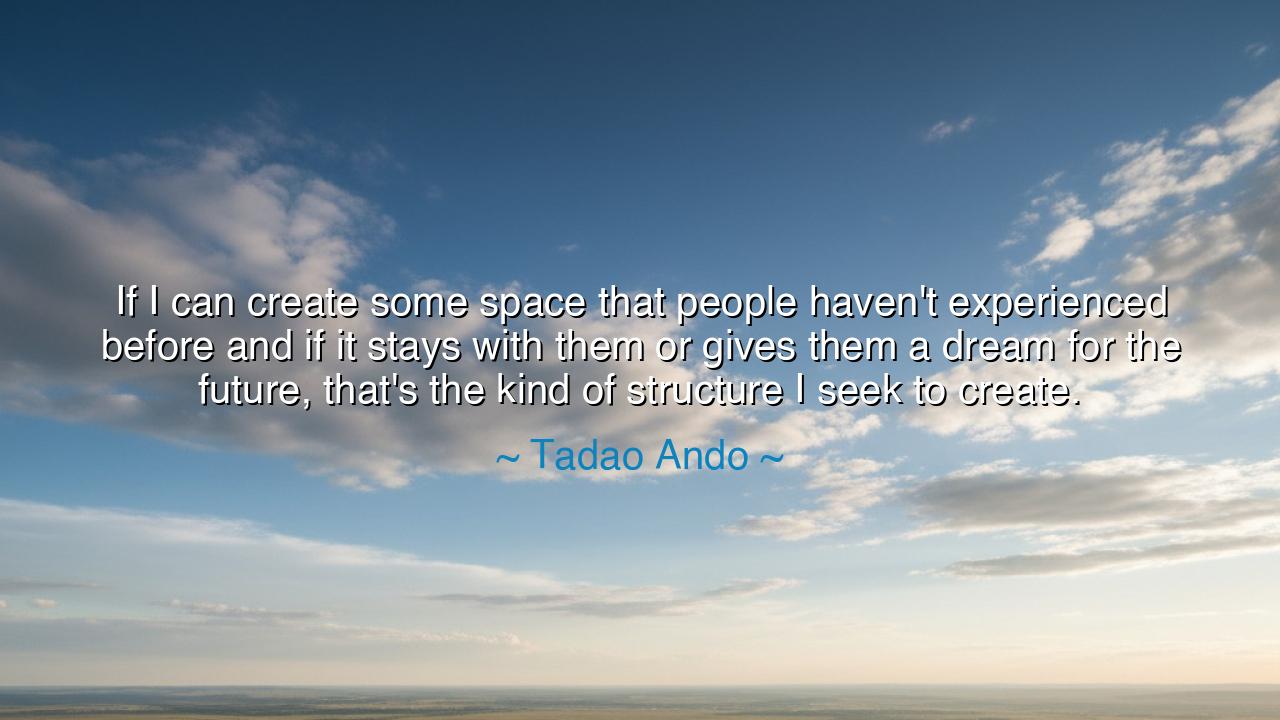
If I can create some space that people haven't experienced before
If I can create some space that people haven't experienced before and if it stays with them or gives them a dream for the future, that's the kind of structure I seek to create.






In the world of creation, there is an ancient and powerful drive to transform the ordinary into something extraordinary, to craft a space that resonates deeply with the human spirit. Tadao Ando, in his profound reflection, speaks to this very essence when he says, "If I can create some space that people haven't experienced before and if it stays with them or gives them a dream for the future, that's the kind of structure I seek to create." His words reflect a deep commitment to more than just the physical space; they point to the emotional and spiritual resonance that space can create in the hearts of those who enter it. It is not enough for a structure to stand simply as an edifice—it must move, inspire, and elevate those who experience it.
The ancients understood well that the built environment is not merely functional but deeply symbolic. In ancient Greece, the Parthenon stood not only as a temple to Athena but as a symbol of Athens' glory, an embodiment of the city's ideals, strength, and aspirations. The Greek philosopher Plato believed that the purpose of art, including architecture, was to reflect the ideal forms—not just the material world, but the deeper, spiritual truths that transcend the physical. Similarly, Ando’s architecture seeks to create spaces that resonate on a much deeper level, spaces that transport individuals beyond the ordinary and into a place where the mind and soul can wander freely, inspired by the beauty and purpose of their surroundings.
Consider the works of the great architect Michelangelo, whose Sistine Chapel in Vatican City transformed not just the space, but the very way people experienced divinity through art. His brushstrokes, bold and sweeping, created not merely a ceiling but a journey through the story of humanity, divinity, and the connection between the two. Each glance upward brought with it a sense of awe, of something greater than oneself. Like Michelangelo, Ando believes that true architecture should awaken the viewer, not through spectacle alone, but through a quiet yet profound sense of wonder. His buildings invite reflection, offering new perspectives, and allowing the individual to step into a realm that feels simultaneously grounded and aspirational.
The story of Rome provides another example of how architecture serves as both symbol and function. The Colosseum, one of the most iconic structures in history, was not only designed to hold crowds for gladiatorial games but also served as a reflection of Rome’s power, its engineering prowess, and its understanding of human nature. The Colosseum brought people together in a shared experience of awe and spectacle, much as Ando seeks to craft spaces that bring people into new experiences—spaces that offer a sense of purpose and transcendence. The Roman Colosseum, though built for entertainment, was a reminder of Roman strength and civic unity, just as Ando's structures aim to remind us of the power of human creativity and the potential of the future.
The lesson Ando imparts, and which the ancients knew well, is that the true power of creation—whether it be in architecture, art, or any form of expression—lies in its ability to shape the human experience. Structures should do more than serve their functional purpose; they should evoke emotions, inspire dreams, and expand the boundaries of what we think is possible. Ando seeks to create spaces that have a lasting impact, that stay with the individual, that spark an inner transformation. His vision is not for mere buildings, but for spaces that have a deeper connection to the human spirit, spaces that speak to our dreams, our hopes, and our collective future.
In our own lives, we must reflect on the spaces we inhabit—not just the physical structures, but the emotional and spiritual spaces we create for ourselves and others. What do we build through our actions, our words, and our contributions to the world? Are we creating structures of meaning, or simply of function? Just as Ando seeks to build spaces that offer new perspectives and inspire people, so too should we aspire to craft our lives in ways that inspire those around us. Our words, our deeds, our relationships—all are spaces we create that can uplift others and build a future of purpose and meaning.
The power of Ando's philosophy is a call to all of us to engage in the act of creation with the intention of leaving something behind that will inspire and transform. Whether we are architects of physical space or of the worlds we shape through our ideas, we must ask ourselves: what is the legacy we are building? Are we building just for the present, or are we creating spaces that will resonate for generations to come? Let us take Ando’s words to heart and strive to create spaces in our own lives that are not just functional but inspiring, that awaken the dreams of those who enter them, and that help to shape a future worthy of the aspirations of all humankind.






AAdministratorAdministrator
Welcome, honored guests. Please leave a comment, we will respond soon